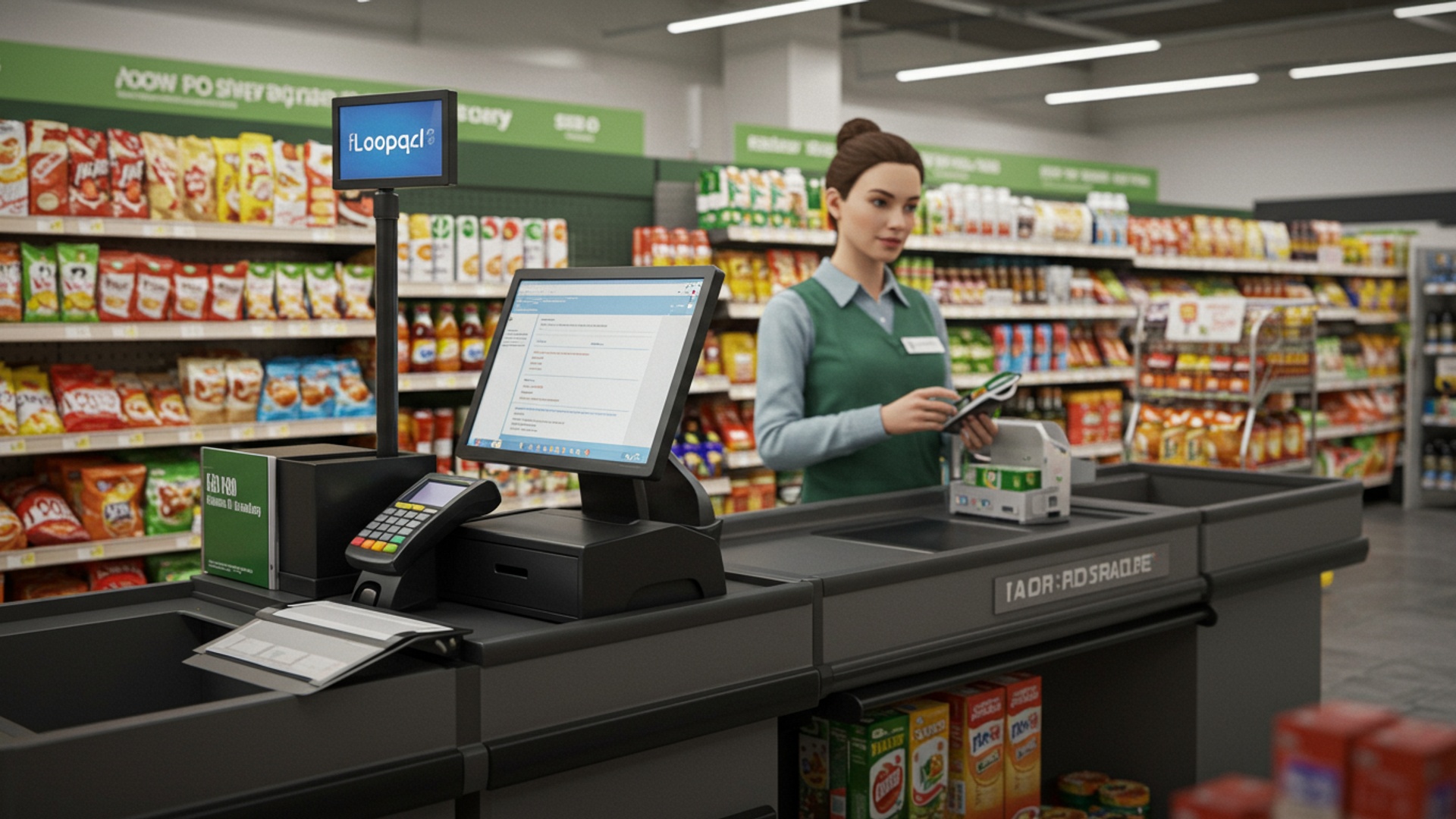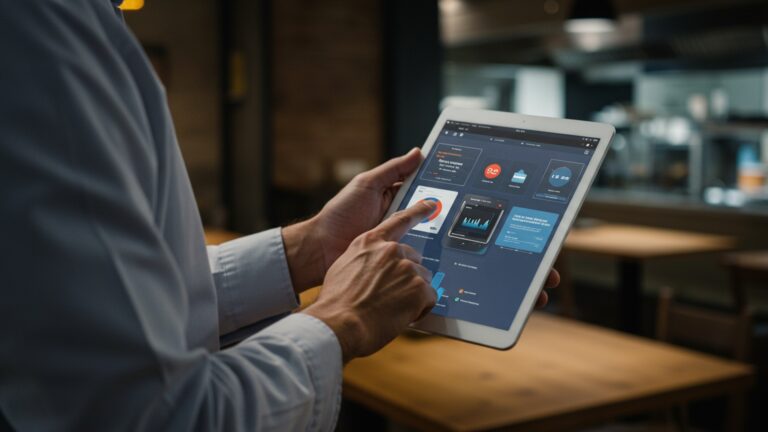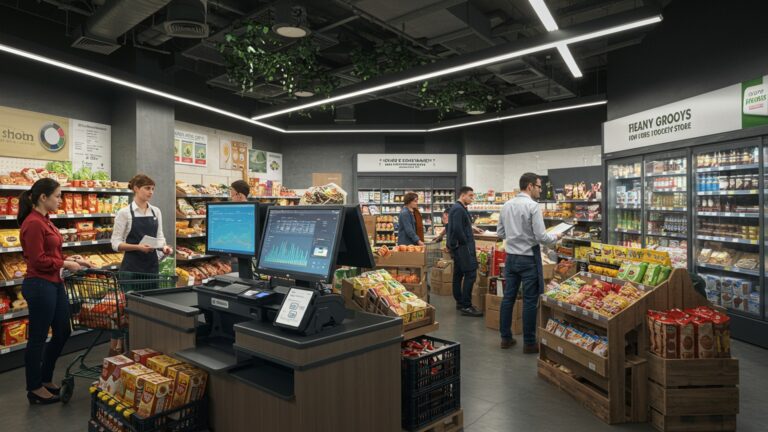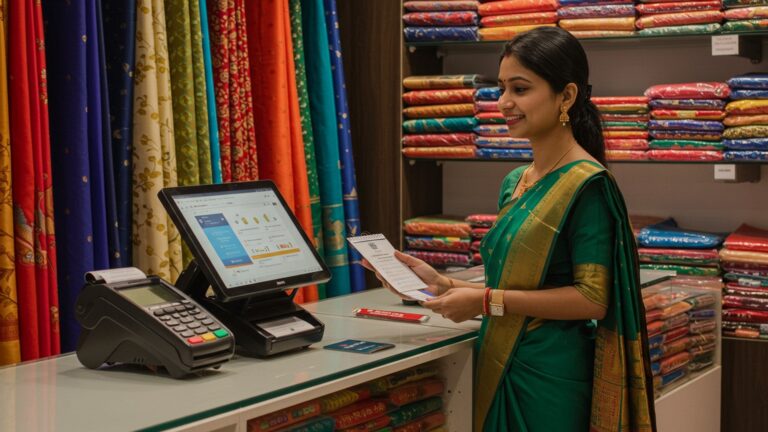How to Implement POS Software for Your Grocery Store to Boost Efficiency
Grocery stores today navigate a complex landscape of fluctuating supply chains, demanding customer expectations for speed. the constant pressure of inventory management. Traditional cash registers and manual tracking simply cannot keep pace with the modern retail environment, where contactless payments and seamless checkout experiences are now standard. Implementing robust pos software for grocery store operations is no longer just an upgrade but a strategic imperative. Advanced systems, like those offering real-time inventory synchronization and integrated customer loyalty programs, empower grocers to minimize spoilage, optimize stock levels. elevate the shopping journey, transforming operational bottlenecks into competitive advantages, ensuring every transaction contributes to overall efficiency and profitability.

Understanding POS Software for Your Grocery Store: The Core Benefits
In today’s fast-paced retail environment, a grocery store’s success hinges significantly on its operational efficiency. At the heart of this efficiency lies Point of Sale (POS) software. A robust pos software for grocery store isn’t just a cash register; it’s a comprehensive management system designed to streamline every aspect of your business, from inventory to customer interactions.
At its core, POS software is a system that processes transactions. But, for a grocery store, its capabilities extend far beyond simply ringing up sales. It integrates various functions that are critical for managing the unique challenges of a grocery business, such as handling perishable goods, managing a vast inventory of diverse products. ensuring quick customer checkout experiences. Implementing an effective POS system can transform your store’s operations, leading to significant improvements in several key areas:
- Faster and More Accurate Checkouts
- Comprehensive Inventory Management
- Detailed Sales Reporting and Analytics
- Enhanced Customer Relationship Management (CRM)
- Reduced Shrinkage and Theft
- Improved Employee Management
Modern POS systems, equipped with barcode scanners and intuitive interfaces, drastically reduce transaction times. This minimizes customer wait times, especially during peak hours. improves overall customer satisfaction. Accuracy is also enhanced, reducing human error in pricing and calculations.
This is arguably one of the most vital benefits for a grocery store. A specialized pos software for grocery store tracks every item sold, allowing for real-time inventory updates. This means you can monitor stock levels, identify fast-moving and slow-moving products. automate reorder alerts, preventing both stockouts and overstocking of perishable goods.
Gain invaluable insights into your business performance. POS software generates detailed reports on sales trends, peak hours, popular products. employee performance. This data empowers you to make informed decisions regarding purchasing, staffing, promotions. store layout.
Many POS systems include features for managing customer data, loyalty programs. targeted promotions. You can track purchase history, offer personalized discounts. build stronger relationships with your regular shoppers, fostering repeat business.
By meticulously tracking inventory and sales, a POS system makes it harder for errors or dishonest activities to go unnoticed. Detailed transaction logs and inventory counts help identify discrepancies, leading to a reduction in losses due to theft or waste.
Track employee hours, manage commissions. monitor individual sales performance. This simplifies payroll processing and helps identify training needs or top-performing staff members.
Key Features to Look for in a Grocery Store POS System
When selecting a pos software for grocery store, it’s crucial to identify features that specifically address the unique demands of your business. Not all POS systems are created equal. a generic retail solution might fall short of a grocery store’s needs. Here’s a breakdown of essential features:
- Advanced Inventory Management
- Support for Perishable Goods
- Batch and Lot Tracking
- Variable Weight Product Handling
- Recipe Management
- Multiple Unit of Measure (UOM)
- Automated Reordering
- Robust Customer Relationship Management (CRM)
- Loyalty Programs
- Customer Database
- Coupon and Discount Management
- Comprehensive Sales Reporting & Analytics
- Real-time Sales Data
- Customizable Reports
- Profitability Analysis
- Loss Prevention Reports
- Integrated Payment Processing
- Support for Various Payment Types
- EMV Compliance
- Contactless Payment Options
- Employee Management
- Time Clock Functionality
- Role-Based Permissions
- Performance Tracking
- Scalability and Multi-Store Management
- Offline Mode
- Supplier Management
- Label Printing
Ability to track expiry dates, manage spoilage. implement FIFO (First-In, First-Out) strategies.
Essential for produce, dairy. other items that arrive in specific batches.
Seamless integration with deli scales, allowing for accurate pricing of items sold by weight (e. g. , meat, produce).
If you have a deli or bakery section, the ability to track ingredients used in prepared foods.
Selling items by individual unit, case, or weight.
Set minimum stock levels to trigger purchase orders automatically.
Create and manage points-based, discount-based, or tiered loyalty programs.
Store purchase history, contact details. preferences for targeted marketing.
Easily apply various types of discounts, promotions. coupons, including multi-buy offers.
Access up-to-the-minute sales figures from anywhere.
Generate reports on sales by product, category, time of day, employee. payment method.
comprehend which products and categories are most profitable.
Identify potential areas of shrinkage or error.
Credit/debit cards, mobile payments (Apple Pay, Google Pay), EBT, gift cards.
Essential for security and reducing liability for fraudulent transactions.
Speed up transactions and offer convenience.
Track employee clock-ins and clock-outs.
Assign different access levels to employees (e. g. , cashiers vs. managers).
Monitor individual sales and efficiency.
If you plan to expand, ensure the system can support multiple locations and centralized management.
Critical for maintaining operations during internet outages, ensuring transactions can still be processed.
Track supplier data, order histories. payment terms.
Generate shelf labels, barcode labels. price tags directly from the system.
A hypothetical scenario might involve a small grocery store owner, Sarah, who initially used a basic cash register. After implementing a new pos software for grocery store with integrated inventory and reporting, she discovered that her organic produce section had higher profit margins than anticipated. she was frequently running out of a popular artisanal bread. With this data, she adjusted her ordering, increased marketing for organic produce. saw a 15% increase in her weekly profits within three months.
Choosing the Right POS Hardware for Your Grocery Store
While the software is the brains, the hardware is the body of your POS system. Selecting the right components is crucial for smooth operations, especially in the demanding environment of a grocery store. Durability, speed. integration capabilities are key considerations. Here’s a breakdown of essential POS hardware components:
- POS Terminal/Tablet
- Traditional Terminals
- Tablets (iPad/Android)
- Barcode Scanner
- Handheld Scanners
- Presentation Scanners (Omnidirectional)
- 2D Imagers
- Receipt Printer
- Thermal Printers
- Impact Printers
- Cash Drawer
- Payment Terminal (PIN Pad)
- Integrated Weight Scale
- Customer Display
- Network Equipment
Robust, fixed stations with touchscreens, ideal for high-volume checkouts. Often more durable and powerful.
Offer flexibility and mobility, suitable for smaller stores, pop-up sales, or inventory checks on the floor. Ensure they are industrial-grade or housed in protective casings for grocery use.
Versatile for scanning items of various sizes, including those in shopping carts.
Allow items to be scanned from any angle without precise alignment, significantly speeding up checkout. Often built into the counter.
Can read QR codes and other 2D barcodes in addition to traditional 1D barcodes.
Fast, quiet. use heat to print, requiring special thermal paper but no ink. Most common in grocery stores.
Use an ink ribbon, slower. can print carbon copies and are suitable for environments where heat might be an issue. Less common in modern grocery settings.
Securely stores cash and coins. Key features include sturdy construction, multiple compartments for different denominations. integration with the POS software for automatic opening upon transaction completion.
A separate device for customers to insert/swipe credit cards, enter PINs. perform contactless payments. It must be EMV-compliant and support NFC (Near Field Communication) for mobile wallets.
Absolutely essential for grocery stores selling produce, bulk items, or deli meats by weight. The scale must seamlessly integrate with your pos software for grocery store to automatically calculate prices based on weight and unit price.
A small screen facing the customer that shows itemized purchases, prices. the total amount. This enhances transparency and reduces disputes.
Reliable internet connection (wired Ethernet preferred for stability), routers. potentially Wi-Fi access points for mobile devices.
When considering hardware, prioritize reliability and seamless integration with your chosen pos software for grocery store. A common pitfall is purchasing incompatible hardware, leading to frustrating setup issues and operational bottlenecks. Always consult with your POS vendor for recommended hardware or purchase bundled solutions to ensure compatibility and support.
The Step-by-Step Implementation Process
Implementing new pos software for grocery store can seem daunting. a structured, phased approach ensures a smooth transition with minimal disruption to your daily operations. Here’s a detailed roadmap:
Phase 1: Planning & Selection
This foundational phase sets the stage for a successful implementation.
- Assess Your Current Needs and Pain Points
- What aspects of your current system are inefficient? (e. g. , slow checkouts, inaccurate inventory, manual reporting).
- What specific features does your grocery store require? (e. g. , deli scale integration, perishable goods tracking, loyalty programs).
- Involve key staff members in this assessment to gather diverse perspectives.
- Research and Compare POS Vendors
- Look for vendors specializing in retail or, even better, grocery stores.
- Consider factors like cloud-based vs. on-premise solutions.
- Cloud-Based POS
- On-Premise POS
- Read reviews, look for case studies from similar businesses.
- Request Demos and Trials
- Budgeting
Data is stored online, accessible from anywhere, automatic updates, subscription model. Requires stable internet.
Software installed on your local servers, more control over data, higher upfront cost, requires IT maintenance. Less reliant on internet for core functions.
Example Comparison Table:
| Feature/Aspect | Cloud-Based POS | On-Premise POS |
|---|---|---|
| Initial Cost | Lower (subscription) | Higher (software license, hardware) |
| Accessibility | Anywhere with internet | Local network (or VPN for remote) |
| Maintenance & Updates | Vendor handles automatically | Your responsibility/IT team |
| Data Security | Vendor’s responsibility (often robust) | Your responsibility |
| Internet Dependency | High (offline mode helps) | Low for core functions |
| Scalability | Easier to scale up/down | May require hardware upgrades |
Don’t commit without seeing the system in action. Ask for a demo tailored to a grocery store environment. If possible, try a free trial to test key features.
Account for software licensing (monthly/annual subscription or one-time purchase), hardware costs, installation, training. ongoing support fees.
Phase 2: Data Migration & Setup
This is where your new system starts to take shape.
- Import Product Data
- This is often the most time-consuming step. Gather all product data: SKUs, barcodes, descriptions, prices, categories, supplier details. initial stock levels.
- Most POS systems allow bulk imports via CSV or Excel files. Ensure data is clean and accurate before import.
-
Example CSV format for product import: SKU,ProductName,Category,Price,Cost,Barcode,StockLevel,Supplier,WeightItem 1001,"Organic Apples","Produce",2. 99,1. 50,001234567890,50,"Local Farm",TRUE 1002,"Whole Wheat Bread","Bakery",3. 50,1. 80,009876543210,20,"City Bakery",FALSE 1003,"Milk (Gallon)","Dairy",4. 25,2. 50,005554443330,30,"Dairy Co." ,FALSE - Set Up Employee Profiles
- Configure Hardware
- Network Setup
- Payment Gateway Integration
Enter employee details, assign roles. configure access permissions. For example, cashiers might only have access to the sales screen, while managers can access inventory and reporting.
Connect and test all hardware components – POS terminals, barcode scanners, receipt printers, cash drawers. especially integrated scales. Ensure they communicate correctly with the pos software for grocery store.
Ensure your internet connection is robust. all devices are securely connected to the network. Consider a backup internet solution for cloud-based systems.
Link your POS system to your chosen payment processor. This involves configuring merchant accounts and testing transactions.
Phase 3: Training
Your team is your greatest asset; ensure they are proficient with the new system.
- Comprehensive Staff Training
- Role-Specific Training
- Practice Runs
- Create Reference Materials
Conduct thorough training sessions for all employees who will interact with the system. This includes cashiers, stock managers. administrative staff.
Tailor training to individual job functions. Cashiers need to master transaction processing, returns. applying discounts. Managers need to comprehend inventory management, reporting. troubleshooting.
Encourage staff to practice using the system in a non-live environment before the go-live date. Simulate various scenarios, including complex transactions and common errors.
Develop simple cheat sheets or quick-reference guides for common tasks and troubleshooting steps.
Phase 4: Go-Live & Post-Implementation
The moment of truth and ongoing optimization.
- Phased Rollout vs. Big Bang
- Phased Rollout
- Big Bang
- On-Site Support
- Monitor and Collect Feedback
- Regular Updates and Maintenance
- Data Backup Strategy
Implement the new system at one register or department first, observe. iron out issues before expanding. This minimizes risk.
Switch all systems over simultaneously. More disruptive but gets the transition over quickly. Recommended only with extensive preparation and confidence.
Have a vendor representative or a designated tech-savvy staff member on site during the initial go-live days to address immediate issues.
Closely monitor system performance and gather feedback from staff and customers. What’s working well? What needs adjustment?
Keep your pos software for grocery store and hardware updated. Software updates often include new features, security patches. performance improvements.
Regularly back up your data, especially for on-premise systems, to prevent data loss in case of hardware failure.
Best Practices for Maximizing Efficiency with Your POS System
Implementing a new pos software for grocery store is just the beginning. To truly unlock its potential and drive efficiency, ongoing best practices are essential. Think of your POS system as a powerful tool that requires skillful use and regular calibration.
- Conduct Regular Inventory Audits
- Utilize Sales Data for Strategic Purchasing
- Implement and Promote Loyalty Programs Effectively
- Cross-Train Your Staff
- Stay Current with Software Updates
- Prioritize Data Security
- Optimize Your Checkout Flow
- Leverage Supplier Integration
While the POS tracks inventory, periodic physical counts are crucial to reconcile discrepancies caused by breakage, spoilage, or undetected theft. This ensures your digital records accurately reflect your physical stock, which is especially crucial for perishable goods.
Don’t just reorder based on instinct. Dive into your POS reports to identify peak sales times, popular products. seasonal trends. Use this data to optimize order quantities, negotiate better deals with suppliers. reduce waste. For example, if your reports show a significant spike in barbecue items during summer weekends, you can proactively increase stock levels for those periods.
Your POS can track customer purchases and manage loyalty points. Actively promote these programs to encourage repeat business. assess customer data to send targeted promotions, such as discounts on frequently purchased items or birthday offers, making customers feel valued.
Ensure multiple employees are proficient in using the POS system beyond basic transactions. This includes managers understanding reporting and inventory. cashiers knowing how to handle returns or apply specific discounts. Cross-training minimizes operational disruptions if key personnel are absent.
POS vendors regularly release updates that include performance enhancements, new features. critical security patches. Regularly apply these updates to ensure your system runs optimally and remains secure.
Your POS system handles sensitive customer and financial data. Ensure your network is secure, use strong passwords. educate staff on data security best practices. Adhere to industry standards like PCI DSS for payment card security.
Periodically observe your checkout process. Are there bottlenecks? Is the hardware ergonomically placed? Ensure barcode scanners are efficient and payment terminals are easily accessible to customers. A smooth checkout experience is a direct reflection of an efficient pos software for grocery store setup.
If your POS offers it, integrate with your suppliers’ systems. This can automate purchase orders, track deliveries. streamline the receiving process, reducing manual data entry and errors.
A real-world example might involve a grocery store manager, David, who noticed through his POS analytics that a specific brand of organic milk was consistently selling out by Wednesday, leading to lost weekend sales. By adjusting his reorder point in the pos software for grocery store and leveraging supplier data, he was able to increase his order frequency and quantity, ensuring stock availability throughout the week and capturing those previously missed sales.
Common Challenges and How to Overcome Them
While implementing a pos software for grocery store brings immense benefits, it’s not without its challenges. Being aware of these potential hurdles and having strategies to overcome them can ensure a smoother transition and long-term success.
- Data Migration Issues
- Challenge
- Solution
- Staff Resistance to Change
- Challenge
- Solution
- Technical Glitches and Downtime
- Challenge
- Solution
- Inadequate Vendor Support
- Challenge
- Solution
- Cost Overruns
- Challenge
- Solution
- Security Concerns
- Challenge
- Solution
Transferring existing product data, customer insights. historical sales records from an old system (or manual records) to the new POS can be complex and prone to errors. Inaccurate data can lead to pricing errors, inventory discrepancies. frustrated customers.
Start data cleaning early. Ensure all existing data is standardized, accurate. free of duplicates. Utilize CSV templates provided by your new POS vendor. Consider hiring a data entry specialist or leveraging vendor support for the migration process. Thoroughly review and verify imported data before going live.
Employees accustomed to an old system may be reluctant to learn new software, fearing complexity, job insecurity, or a slowdown in their work. This resistance can hinder adoption and negate efficiency gains.
Involve staff early in the selection process. Clearly communicate the benefits of the new system (e. g. , faster checkouts, easier inventory checks). Provide extensive, hands-on training tailored to their roles. Designate “super users” or “POS champions” among staff who can assist peers and foster a positive attitude towards the new technology. Emphasize that the system is a tool to make their jobs easier, not harder.
Unexpected software bugs, hardware malfunctions, or internet outages can disrupt operations, leading to lost sales and customer dissatisfaction.
Choose a reputable POS vendor with a strong track record of reliability and excellent customer support. Ensure your hardware is robust and suitable for a demanding grocery environment. Implement a reliable internet connection with a backup solution (e. g. , cellular hotspot for cloud-based systems). Utilize offline mode functionality if available. Have a clear troubleshooting guide and know how to contact vendor support quickly.
Poor or slow support from your POS vendor can leave you stranded when issues arise, impacting your ability to serve customers.
During the selection phase, thoroughly vet the vendor’s support options. Look for 24/7 support, multiple contact channels (phone, email, chat). clear service level agreements (SLAs). Read reviews specifically about their support quality. A good relationship with your vendor is paramount for long-term success with your pos software for grocery store.
Unforeseen costs for hardware, additional software modules, installation, or ongoing support can inflate the initial budget.
Get a detailed, itemized quote from your vendor that includes all potential costs. Ask about hidden fees or charges for future updates or specific features. Plan for a contingency budget (10-15% of the total project cost) to cover unexpected expenses. Consider leasing hardware to spread costs.
Protecting customer data, payment details. your business’s financial records from cyber threats or internal misuse.
Choose a PCI DSS compliant POS system and payment processor. Implement strong password policies and multi-factor authentication for staff. Regularly update software to patch vulnerabilities. Train employees on security best practices, such as identifying phishing attempts and protecting sensitive data.
Conclusion
Implementing new POS software in your grocery store isn’t merely a tech upgrade; it’s a strategic overhaul of your daily operations. From my experience, the true efficiency boost comes not just from the software’s capabilities. from a meticulous rollout plan, comprehensive staff training. a willingness to adapt. Remember, even the most advanced system won’t optimize your fresh produce inventory or streamline checkout if your team isn’t comfortable using it. Dedicate a “POS Champion” within your staff—someone enthusiastic to learn the system inside out and become the go-to person for questions, accelerating adoption across the board. Embrace this transition as an investment in your grocery store’s future. Modern POS systems, with their integrated inventory management and robust reporting, are crucial for navigating current trends like dynamic pricing and customer loyalty programs. By leveraging data-driven insights and exploring options like cloud-based solutions, you’re not just selling groceries; you’re building a more responsive, profitable business ready for tomorrow’s challenges. The journey may have its moments. the enhanced customer experience and operational clarity are profoundly rewarding.
More Articles
Enhance Your Retail Store How to Implement POS Software Effectively
Understanding POS Software A Practical Guide to Streamlining Your Retail Business
Why Cloud Based POS Software is Your Business Future Learn How to Adopt It
How to Choose the Best Billing and POS Software for Your Business Needs
FAQs
Why should my grocery store even consider getting POS software? What’s the big deal?
It’s a game-changer for efficiency! A good POS system speeds up checkout lines, tracks inventory automatically so you know what’s selling and what’s not, helps manage staff. even gives you insights into your sales data. , it helps you run your store smarter, not just harder.
There are tons of POS systems out there. How do I even start picking the right one for my grocery store?
First, list what your store really needs – like inventory management for fresh produce, quick barcode scanning, customer loyalty programs, or scale integration for weighted items. Then, look for systems that specialize in grocery or retail, offer good customer support. fit your budget. Don’t be afraid to ask for demos!
Okay, I’ve picked one. What’s the actual process for getting a new POS system up and running in my grocery store?
It typically involves a few key steps: hardware setup (terminals, scanners, printers), software installation, data import (all your product info and inventory), configuration (payment methods, taxes). thorough staff training. It sounds like a lot. most providers guide you through it.
My staff isn’t super tech-savvy. Will they actually be able to use this new POS system without a lot of headaches?
Absolutely! Modern POS systems are designed to be user-friendly, often with intuitive touch screens and clear interfaces. The key is thorough training. Make sure your team gets hands-on practice before going live. provide cheat sheets or quick guides. Good software minimizes the learning curve, making it easy for everyone.
I have hundreds, maybe thousands, of products. How do I get all my existing inventory and product info into the new POS system without a massive headache?
This is a big one! Most POS systems allow for bulk data import using spreadsheets (like Excel). You’ll typically export your current product list, format it to match the new system’s requirements (product name, SKU, price, inventory count, etc.). then upload it. It might take some initial effort to clean up your data. it’s crucial for accurate tracking from day one.
Everyone talks about efficiency. does a POS system really deliver on that promise and actually save my grocery store money in the long run?
Definitely! By automating inventory, you reduce waste and avoid stockouts. Faster checkouts mean happier customers and more sales. Data analytics help you make smarter purchasing decisions and optimize staffing. Plus, better tracking reduces errors and potential theft. All these add up to significant time and cost savings, boosting your bottom line.
What if something breaks or I have a question after the POS system is all set up and we’re live? What kind of support can I expect?
That’s where good customer support comes in! Before you commit, check what kind of support the provider offers – phone, email, chat, or even on-site visits. Most reputable companies offer ongoing support and troubleshooting to help you with any issues, whether it’s a technical glitch or just a question about a feature. Make sure they’re available when you need them.





